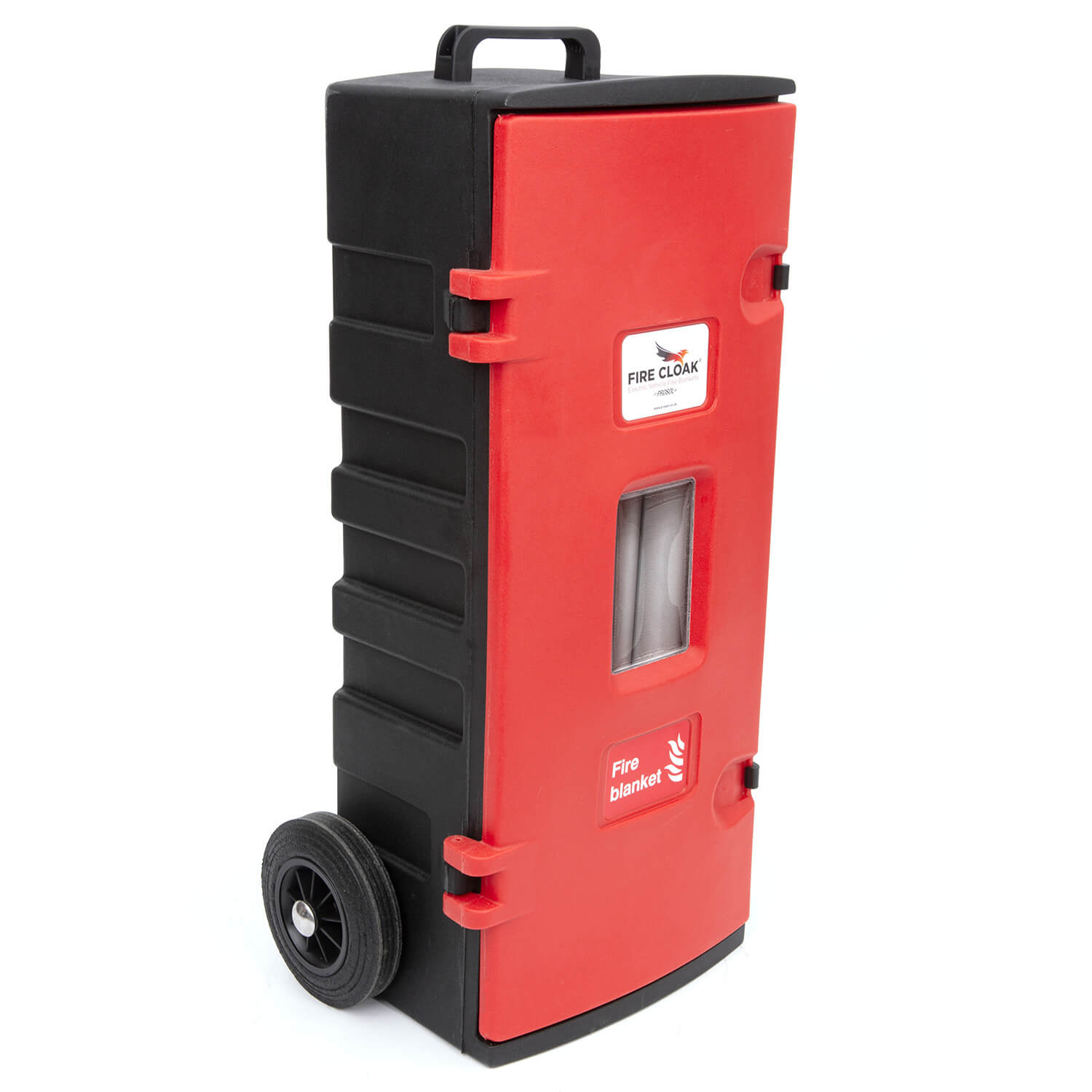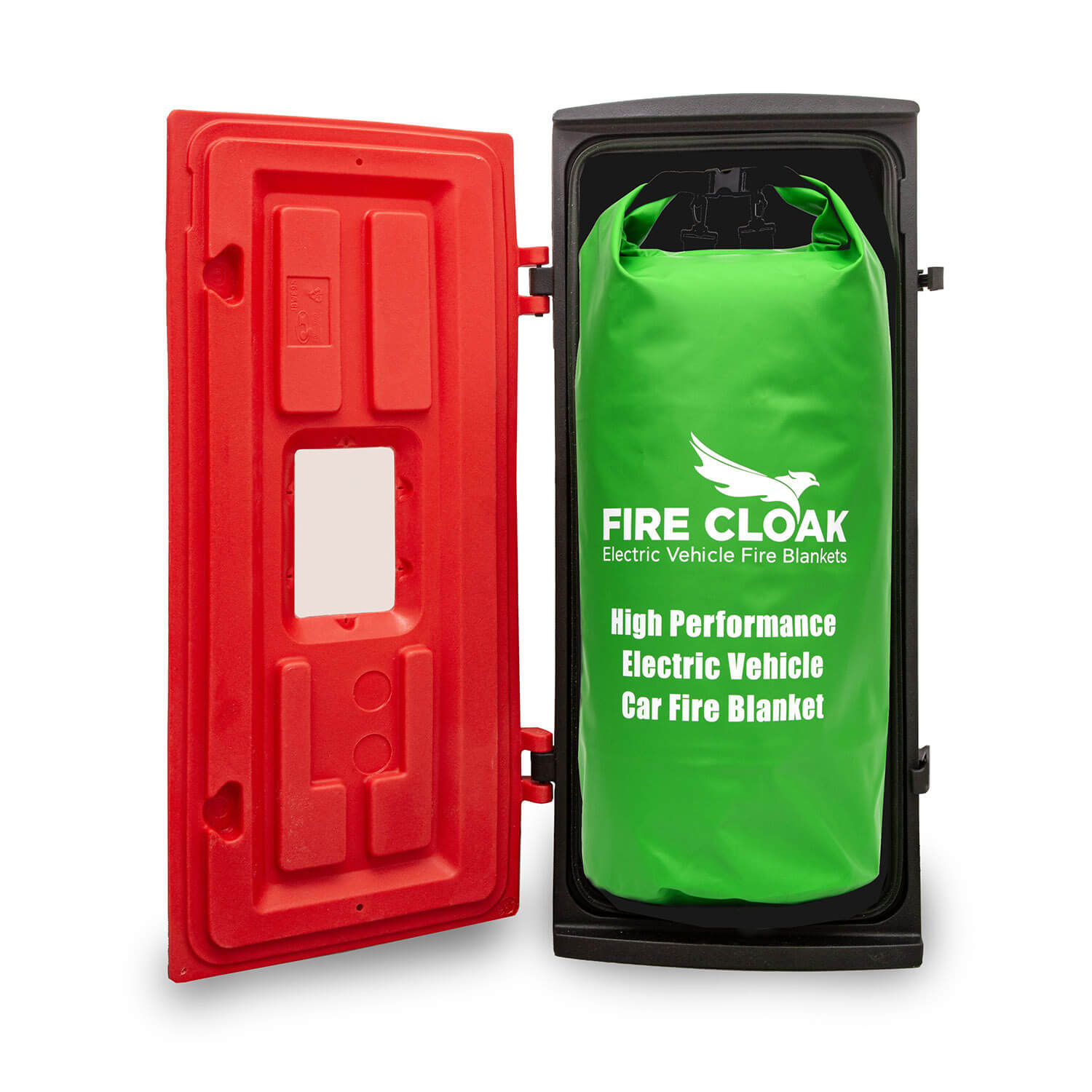Designed to contain Electric and Hybrid Vehicle fires, the EV Car Fire Blanket has been developed after many months of research and development.
The most common form of fire in electric or hybrid vehicles is when the high energy battery is damaged, or a manufacturing fault results in a short circuit. The battery can then go into “Thermal Runaway”, this is a phenomenon where damaged cells heat up rapidly to such an extent that a fire starts. The fire then compromises adjoining cells and a “domino effect” occurs spreading to the whole battery array.
Thermal Runaway fires cannot be extinguished by conventional means!
The electrolyte in a Lithium-Ion battery usually contains hydrocarbon solvents which fuels the fire. If unchecked extremely high temperatures can result.
Utilising an EV Car Fire Blanket minimises the combustion potential by depriving the fire of Oxygen. This inhibits the fire and consequently temperatures drop rapidly, reducing potential damage to surrounding vehicles and property.
The EV Car Fire Blanket can be deployed easily by two people and is supplied in a convenient storage holdall for protection and ease of transport.
Product Description:
Specially modified glass fibre fabric (FBM8060) with fire resistant silicone coating to both sides.
4 x heavy-duty, fire resistant pull handles to corners with triple layer reinforced mounting points.
All seams and handles stitched with high temperature resistant thread.
Dimensions: 8 x 6 metres – Weight: c.28kg (includes storage bag).
Base Material Specification – Product Code: FBM8060
| Property | Units | Value | Tolerance |
|---|---|---|---|
| Weight | g/m2 | 420+100 | ± 5% |
| Silicone Coating | g/m2 | 50 (each side) | ± 10% |
| Tensile Strength – Warp | N | 1400 | ± 2% |
| Tensile Strength – Weft | N | 1000 | ± 2% |
| Tear Strength | N | >128 | ± 2% |
| Burst Strength | kPa | >1000 | ± 4% |
Base Material FBM8060 Test Data:
BS 476: Part 7: 1997 : Surface Spread of Flame – Compliant
BS 476: Part 6: 1989 + A1:2009 : Fire Propagation Index – Compliant
Based on the above test results the product is deemed as meeting a CLASS 0 RATING for fire resistance.
This is similar to the CLASS A fire resistance rating in the USA.
BS 476-20/22 1987 (similar to USA standard ASTM E119) : Indicative Furnace Test – Resisted 1,000°C (1,832°F) for 90 minutes, at which point the test was stopped.
D6413 / D6413M-22 : USA standard for Vertical Flame Resistance – PASSED with Best Possible Result.
NFPA 701 : USA standard for Flame Propagation of Textiles – PASSED and NFPA certified.
ISO EN 13501-1 2018 : European Standard for Fire Classification of Products – Rating: A2, s1, d0
Additional Tests by Intertek Testing Services (UK) Ltd – average results
| BS EN ISO 14419:2010 | Hydrocarbon Resistance | 7 |
| BS EN ISO 9237:1995 | Air Permeability @ 20°C | 0.22 mm/s |
| BS EN ISO 9237:1995 | Air Permeability @ 400°C | 0.63 mm/s |
| BS EN ISO 13934-1:2013 | Tensile Properties 1 Hr @ 400°C | Warp ~ 1156.6N Weft ~ 1012.5N |
| BS EN 20811:1992/ISO 811:1981 | Hydrostatic Pressure Test – cm/H2O (Mbar) | 492 |
Live testing at Horiba MIRA (Motor Industry Research Association, Nuneaton, UK)
The Fire CloakTM EV Fire Blanket was deployed over a burning Nissan Leaf that was in an advanced stage of Thermal Runaway. The fire temperature dropped rapidly from over 900°C to 47°C in under 10 minutes.
Designed to contain Electric and Hybrid Vehicle fires, the EV Car Fire Blanket has been developed after many months of research and development.
The most common form of fire in electric or hybrid vehicles is when the high energy battery is damaged, or a manufacturing fault results in a short circuit. The battery can then go into “Thermal Runaway”, this is a phenomenon where damaged cells heat up rapidly to such an extent that a fire starts. The fire then compromises adjoining cells and a “domino effect” occurs spreading to the whole battery array.
Thermal Runaway fires cannot be extinguished by conventional means!
The electrolyte in a Lithium-Ion battery usually contains hydrocarbon solvents which fuels the fire. If unchecked extremely high temperatures exceeding 1,200°C+ can result.
Utilising an EV Car Fire Blanket minimises the combustion potential by depriving the fire of Oxygen. This inhibits the fire and consequently temperatures drop rapidly, reducing potential damage to surrounding vehicles and property.
The EV Car Fire Blanket can be deployed easily by two people and is supplied in a convenient storage holdall for protection and ease of transport.
Specially modified glass fibre fabric (FBM8060) with fire resistant silicone coating to both sides.
4 x heavy-duty, fire resistant pull handles to corners with triple layer reinforced mounting points.
All seams and handles stitched with high temperature resistant thread.
Dimensions: 8 x 6 metres – Weight: c.28kg (includes storage bag).
Base Material Specification – Product Code: FBM8060
| Property | Units | Value | Tolerance |
|---|---|---|---|
| Weight | g/m2 | 420+100 | ± 5% |
| Silicone Coating | g/m2 | 50 (each side) | ± 10% |
| Tensile Strength – Warp | N | 1400 | ± 2% |
| Tensile Strength – Weft | N | 1000 | ± 2% |
| Tear Strength | N | >128 | ± 2% |
| Burst Strength | kPa | >1000 | ± 4% |
Base Material FBM8060 Test Data:
BS 476: Part 7: 1997 : Surface Spread of Flame – Compliant
BS 476: Part 6: 1989 + A1:2009 : Fire Propagation Index – Compliant
Based on the above test results the product is deemed as meeting a CLASS 0 RATING for fire resistance.
This is similar to the CLASS A fire resistance rating in the USA.
BS 476-20/22 1987 (similar to USA standard ASTM E119) : Indicative Furnace Test – Resisted 1,000°C (1,832°F) for 90 minutes, at which point the test was stopped.
D6413 / D6413M-22 : USA standard for Vertical Flame Resistance – PASSED with Best Possible Result.
NFPA 701 : USA standard for Flame Propagation of Textiles – PASSED and NFPA certified.
ISO EN 13501-1 2018 : European Standard for Fire Classification of Products – Rating: A2, s1, d0
Additional Tests by Intertek Testing Services (UK) Ltd – average results
| BS EN ISO 14419:2010 | Hydrocarbon Resistance | 7 |
| BS EN ISO 9237:1995 | Air Permeability @ 20°C | 0.22 mm/s |
| BS EN ISO 9237:1995 | Air Permeability @ 400°C | 0.63 mm/s |
| BS EN ISO 13934-1:2013 | Tensile Properties 1 Hr @ 400°C | Warp ~ 1156.6N Weft ~ 1012.5N |
| BS EN 20811:1992/ISO 811:1981 | Hydrostatic Pressure Test – cm/H2O (Mbar) | 492 |
Live testing at Horiba MIRA (Motor Industry Research Association, Nuneaton, UK)
The Fire CloakTM EV Fire Blanket was deployed over a burning Nissan Leaf that was in an advanced stage of Thermal Runaway. The fire temperature dropped rapidly from over 900°C to 47°C in under 10 minutes.

















